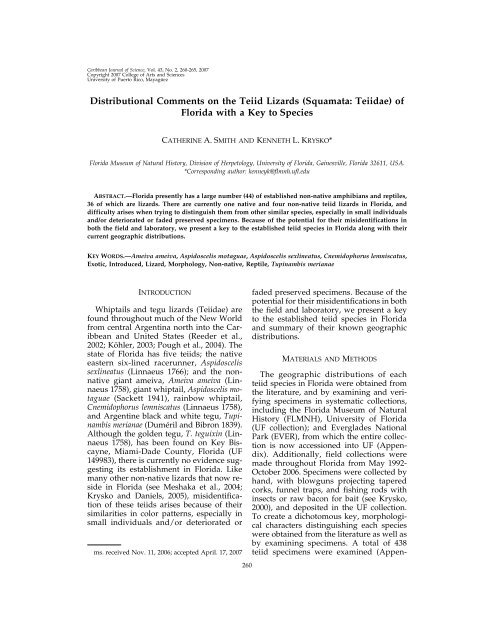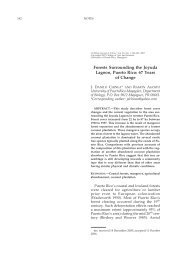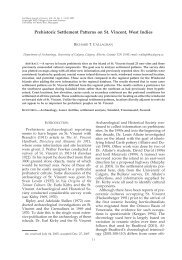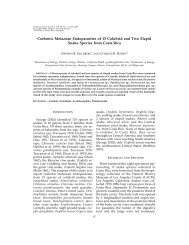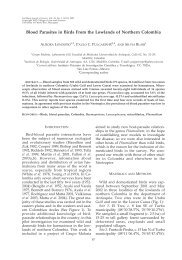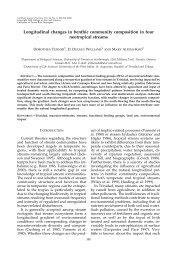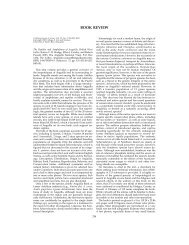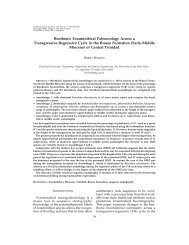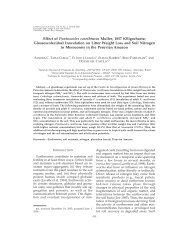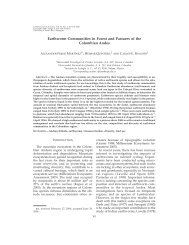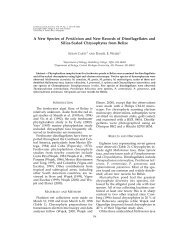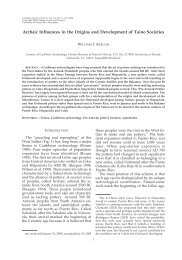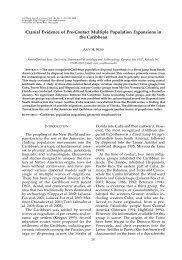Distributional Comments on the Teiid Lizards - Caribbean Journal of ...
Distributional Comments on the Teiid Lizards - Caribbean Journal of ...
Distributional Comments on the Teiid Lizards - Caribbean Journal of ...
Create successful ePaper yourself
Turn your PDF publications into a flip-book with our unique Google optimized e-Paper software.
<strong>Caribbean</strong> <strong>Journal</strong> <strong>of</strong> Science, Vol. 43, No. 2, 260-265, 2007<br />
Copyright 2007 College <strong>of</strong> Arts and Sciences<br />
University <strong>of</strong> Puerto Rico, Mayagüez<br />
<str<strong>on</strong>g>Distributi<strong>on</strong>al</str<strong>on</strong>g> <str<strong>on</strong>g>Comments</str<strong>on</strong>g> <strong>on</strong> <strong>the</strong> <strong>Teiid</strong> <strong>Lizards</strong> (Squamata: <strong>Teiid</strong>ae) <strong>of</strong><br />
Florida with a Key to Species<br />
CATHERINE A. SMITH AND KENNETH L. KRYSKO*<br />
Florida Museum <strong>of</strong> Natural History, Divisi<strong>on</strong> <strong>of</strong> Herpetology, University <strong>of</strong> Florida, Gainesville, Florida 32611, USA.<br />
*Corresp<strong>on</strong>ding author: kenneyk@flmnh.ufl.edu<br />
ABSTRACT.—Florida presently has a large number (44) <strong>of</strong> established n<strong>on</strong>-native amphibians and reptiles,<br />
36 <strong>of</strong> which are lizards. There are currently <strong>on</strong>e native and four n<strong>on</strong>-native teiid lizards in Florida, and<br />
difficulty arises when trying to distinguish <strong>the</strong>m from o<strong>the</strong>r similar species, especially in small individuals<br />
and/or deteriorated or faded preserved specimens. Because <strong>of</strong> <strong>the</strong> potential for <strong>the</strong>ir misidentificati<strong>on</strong>s in<br />
both <strong>the</strong> field and laboratory, we present a key to <strong>the</strong> established teiid species in Florida al<strong>on</strong>g with <strong>the</strong>ir<br />
current geographic distributi<strong>on</strong>s.<br />
KEY WORDS.—Ameiva ameiva, Aspidoscelis motaguae, Aspidoscelis sexlineatus, Cnemidophorus lemniscatus,<br />
Exotic, Introduced, Lizard, Morphology, N<strong>on</strong>-native, Reptile, Tupinambis merianae<br />
INTRODUCTION<br />
Whiptails and tegu lizards (<strong>Teiid</strong>ae) are<br />
found throughout much <strong>of</strong> <strong>the</strong> New World<br />
from central Argentina north into <strong>the</strong> <strong>Caribbean</strong><br />
and United States (Reeder et al.,<br />
2002; Köhler, 2003; Pough et al., 2004). The<br />
state <strong>of</strong> Florida has five teiids; <strong>the</strong> native<br />
eastern six-lined racerunner, Aspidoscelis<br />
sexlineatus (Linnaeus 1766); and <strong>the</strong> n<strong>on</strong>native<br />
giant ameiva, Ameiva ameiva (Linnaeus<br />
1758), giant whiptail, Aspidoscelis motaguae<br />
(Sackett 1941), rainbow whiptail,<br />
Cnemidophorus lemniscatus (Linnaeus 1758),<br />
and Argentine black and white tegu, Tupinambis<br />
merianae (Duméril and Bibr<strong>on</strong> 1839).<br />
Although <strong>the</strong> golden tegu, T. teguixin (Linnaeus<br />
1758), has been found <strong>on</strong> Key Biscayne,<br />
Miami-Dade County, Florida (UF<br />
149983), <strong>the</strong>re is currently no evidence suggesting<br />
its establishment in Florida. Like<br />
many o<strong>the</strong>r n<strong>on</strong>-native lizards that now reside<br />
in Florida (see Meshaka et al., 2004;<br />
Krysko and Daniels, 2005), misidentificati<strong>on</strong><br />
<strong>of</strong> <strong>the</strong>se teiids arises because <strong>of</strong> <strong>the</strong>ir<br />
similarities in color patterns, especially in<br />
small individuals and/or deteriorated or<br />
The geographic distributi<strong>on</strong>s <strong>of</strong> each<br />
teiid species in Florida were obtained from<br />
<strong>the</strong> literature, and by examining and verifying<br />
specimens in systematic collecti<strong>on</strong>s,<br />
including <strong>the</strong> Florida Museum <strong>of</strong> Natural<br />
History (FLMNH), University <strong>of</strong> Florida<br />
(UF collecti<strong>on</strong>); and Everglades Nati<strong>on</strong>al<br />
Park (EVER), from which <strong>the</strong> entire collecti<strong>on</strong><br />
is now accessi<strong>on</strong>ed into UF (Appendix).<br />
Additi<strong>on</strong>ally, field collecti<strong>on</strong>s were<br />
made throughout Florida from May 1992-<br />
October 2006. Specimens were collected by<br />
hand, with blowguns projecting tapered<br />
corks, funnel traps, and fishing rods with<br />
insects or raw bac<strong>on</strong> for bait (see Krysko,<br />
2000), and deposited in <strong>the</strong> UF collecti<strong>on</strong>.<br />
To create a dichotomous key, morphological<br />
characters distinguishing each species<br />
were obtained from <strong>the</strong> literature as well as<br />
by examining specimens. A total <strong>of</strong> 438<br />
teiid specimens were examined (Appenms.<br />
received Nov. 11, 2006; accepted April. 17, 2007<br />
260<br />
faded preserved specimens. Because <strong>of</strong> <strong>the</strong><br />
potential for <strong>the</strong>ir misidentificati<strong>on</strong>s in both<br />
<strong>the</strong> field and laboratory, we present a key<br />
to <strong>the</strong> established teiid species in Florida<br />
and summary <strong>of</strong> <strong>the</strong>ir known geographic<br />
distributi<strong>on</strong>s.<br />
MATERIALS AND METHODS
FLORIDA TEIID LIZARDS 261<br />
dix), including 58 Ameiva ameiva, 58Cnemidophorus<br />
lemniscatus, 16 Aspidoscelis motaguae,<br />
300 Aspidoscelis sexlineatus, and six<br />
Tupinambis merianae.<br />
RESULTS<br />
FIG. 1. Ventral views, typical teiid lizards showing<br />
large, rectangular, and plate-like ventral scales. Ventral<br />
scales in (A) 10-12 or (B) 8 l<strong>on</strong>gitudinal rows at<br />
midbody (highlighted in gray). Illustrated from: A =<br />
Ameiva ameiva, UF 142905, Key Biscayne, Miami-Dade<br />
County, Florida; B = Aspidoscelis sexlineatus, UF<br />
141200, Key West, M<strong>on</strong>roe County, Florida.<br />
<strong>Teiid</strong>s differ from all o<strong>the</strong>r known lizards<br />
in Florida by having large, rectangular and<br />
plate-like ventral scales. A key to <strong>the</strong> teiids<br />
<strong>of</strong> Florida is presented in Table 1.<br />
Ameiva ameiva.—N<strong>on</strong>-native. The native<br />
distributi<strong>on</strong> includes <strong>the</strong> Atlantic versant <strong>of</strong><br />
South America from sou<strong>the</strong>rn Brazil, Paraguay,<br />
Peru, nor<strong>the</strong>rn Argentina, north to<br />
Colombia, Panama, Costa Rica, Trinidad,<br />
Tobago, Isla de Providencia, Grenada, and<br />
Grenadines (Barbour and Noble, 1915,<br />
1920; Schwartz and Henders<strong>on</strong>, 1991; Vitt<br />
and Colli, 1994; Savage, 2002; Reeder et al.,<br />
2002; Köhler, 2003). It is believed to have<br />
been extirpated from St. Vincent (Malhotra<br />
and Thorpe, 1999). Duellman and Schwartz<br />
(1958) first recorded A. ameiva in Florida<br />
collected in June 1954 from Miami (UMMZ<br />
111408; also see Neill, 1957:207). In Florida,<br />
this species occurs in Deerfield Beach, Broward<br />
County (Krysko et al., 2005), Miami,<br />
Hialeah, and Key Biscayne, Miami-Dade<br />
County. One specimen (LACM 116128) was<br />
collected in 1955 <strong>on</strong> Key West, M<strong>on</strong>roe<br />
County. Ano<strong>the</strong>r individual was observed<br />
at Green Acres, Palm Beach County <strong>on</strong> 1<br />
March 2003 (M. A. Nickers<strong>on</strong>, pers.<br />
comm.), but not collected. Ameiva ameiva is<br />
distinguished by having 10-12 l<strong>on</strong>gitudinal<br />
rows <strong>of</strong> ventrals at midbody (Table 1; Fig.<br />
1A). O<strong>the</strong>r morphological characters include<br />
<strong>on</strong>e row <strong>of</strong> greatly enlarged scales <strong>on</strong><br />
outside <strong>of</strong> upper arm; presence <strong>of</strong> a fleshy<br />
sheath enclosing base <strong>of</strong> t<strong>on</strong>gue; posterior<br />
porti<strong>on</strong> <strong>of</strong> t<strong>on</strong>gue not clearly forked;<br />
smooth ventrals; absence <strong>of</strong> cloacal spurs in<br />
males; mesoptychial scales not enlarged <strong>on</strong><br />
gular fold; granular dorsal scales; <strong>on</strong>togenetic<br />
shift in dorsal color pattern occurs (especially<br />
in males); dorsal pattern olive,<br />
brown, or tan, sometimes with a green or<br />
blue cast with 5 pale l<strong>on</strong>gitudinal stripes<br />
and light spots; a greenish to brown head;<br />
throat and chest with pale blue and black<br />
spots; venter light-colored white to blue;<br />
and maximum size <strong>of</strong> 197 mm snout-vent<br />
length (SVL) (C<strong>on</strong>ant and Collins, 1998;<br />
Schwartz and Henders<strong>on</strong>, 1991; Köhler,<br />
2003).<br />
Aspidoscelis motaguae.—N<strong>on</strong>-native. The<br />
TABLE 1. Key to <strong>the</strong> teiids <strong>of</strong> Florida.<br />
1a Ventral scales large, rectangular, and plate-like (Fig. 1) ....................................................................................... 2<br />
b Ventral scales not large, rectangular, and plate-like ........................................ o<strong>the</strong>r lizard families in Florida<br />
2a Ventral scales in 8 l<strong>on</strong>gitudinal rows at midbody (Fig. 1B) ................................................................................. 3<br />
2b Ventral scales in >8 l<strong>on</strong>gitudinal rows at midbody (Fig. 1A) ............................................................................. 5<br />
3a Four parietals (Fig. 2A) ............................................................................................... Cnemidophorus lemniscatus<br />
b Two parietals (Fig. 2B) ................................................................................................................................................ 4<br />
4a<br />
b<br />
5a<br />
b<br />
31-35 enlarged scales from posterior end <strong>of</strong> gular fold to femoral pores (Fig. 3) .. Aspidoscelis sexlineatus<br />
37-39 enlarged scales from posterior end <strong>of</strong> gular fold to femoral pores .................. Aspidoscelis motaguae<br />
Ventral scales in 10-12 l<strong>on</strong>gitudinal rows at midbody (Fig. 1A) ............................................... Ameiva ameiva<br />
Ventral scales in >12 l<strong>on</strong>gitudinal rows at midbody ....................................................... Tupinambis merianae
262<br />
C. A. SMITH AND K. R. KRYSKO<br />
native distributi<strong>on</strong> includes a disc<strong>on</strong>tinuous<br />
range in sub-humid envir<strong>on</strong>ments<br />
from central Oaxaca, Mexico through <strong>the</strong><br />
middle Grijalva Valle in <strong>the</strong> central depressi<strong>on</strong><br />
<strong>of</strong> Chiapas, <strong>the</strong> Salamá Basin, and upper<br />
Motagua Valley in Guatemala. It is also<br />
found in central H<strong>on</strong>duras, sou<strong>the</strong>astern<br />
Guatemala, and adjacent El Salvador (Duellman<br />
and Zweifel, 1962). In Florida, it has<br />
been introduced in three known localities<br />
in Miami-Dade County: Hialeah; just north<br />
<strong>of</strong> Snapper Creek between SW 117 Avenue<br />
and <strong>the</strong> Florida Turnpike; and south <strong>of</strong> <strong>the</strong><br />
Taylor Slough entrance to Everglades Nati<strong>on</strong>al<br />
Park (formerly Chekika State Park).<br />
This species is distinguished by having<br />
eight l<strong>on</strong>gitudinal rows <strong>of</strong> ventrals at midbody<br />
(Table 1; Fig. 1B), two parietals (Fig.<br />
2B), and 37-39 enlarged scales from <strong>the</strong> posterior<br />
end <strong>of</strong> <strong>the</strong> gular fold to femoral pores<br />
(Fig. 3). O<strong>the</strong>r morphological characters include<br />
3 greatly enlarged scales <strong>on</strong> outside<br />
FIG. 2. Ventral view, 31-35 enlarged scales (highlighted<br />
in gray) from posterior end <strong>of</strong> gular fold to<br />
femoral pores. Illustrated from Aspidoscelis sexlineatus,<br />
UF 141200, Key West, M<strong>on</strong>roe County, Florida.<br />
FIG. 3. Dorsal view, four (A) or two (B) parietal<br />
scales (highlighted in gray) <strong>on</strong> top <strong>of</strong> head. Illustrated<br />
from: A = Cnemidophorus lemniscatus, UF 131481, Hialeah,<br />
Miami-Dade County, Florida; B = Aspidoscelis<br />
motaguae, UF 144199, Miami, Miami-Dade County,<br />
Florida.<br />
<strong>of</strong> upper arm; no fleshy sheath enclosing<br />
base <strong>of</strong> t<strong>on</strong>gue; posterior porti<strong>on</strong> <strong>of</strong> t<strong>on</strong>gue<br />
clearly forked; smooth ventrals; absence <strong>of</strong><br />
cloacal spurs in males; mesoptychial scales<br />
abruptly enlarged <strong>on</strong> gular fold becoming<br />
smaller anteriorly; granular dorsal scales;<br />
dorsal pattern <strong>of</strong> juveniles black to brown<br />
with six light-colored l<strong>on</strong>gitudinal stripes,<br />
stripes usually completely replaced by light<br />
spots in adults; venter light-colored white<br />
to blue; and maximum size <strong>of</strong> 145 mm SVL<br />
(Reeder et al., 2002; Köhler, 2003).<br />
Aspidoscelis sexlineatus.—Native. Occurs<br />
from eastern Texas and Missouri east to<br />
Maryland and Florida. In Florida, it occurs<br />
throughout <strong>the</strong> panhandle, and most <strong>of</strong> <strong>the</strong><br />
peninsula south to Key West (C<strong>on</strong>ant and<br />
Collins, 1998). This species is distinguished<br />
by having eight l<strong>on</strong>gitudinal rows <strong>of</strong> ventrals<br />
at midbody (Table 1; Fig. 1B), two parietals<br />
(Fig. 2B), and 31-35 enlarged scales<br />
from <strong>the</strong> posterior end <strong>of</strong> <strong>the</strong> gular fold to<br />
femoral pores (Fig. 3). O<strong>the</strong>r morphological<br />
characters include scales <strong>on</strong> outside <strong>of</strong> rear<br />
<strong>of</strong> forearm slightly or not enlarged; no<br />
fleshy sheath enclosing base <strong>of</strong> t<strong>on</strong>gue; posterior<br />
porti<strong>on</strong> <strong>of</strong> t<strong>on</strong>gue clearly forked;<br />
smooth ventrals; absence <strong>of</strong> cloacal spurs in<br />
males; mesoptychial scales abruptly enlarged<br />
<strong>on</strong> gular fold becoming smaller anteriorly;<br />
granular dorsal scales; dorsal pat-
FLORIDA TEIID LIZARDS 263<br />
tern black to brown with six light-colored<br />
l<strong>on</strong>gitudinal stripes and no spots; venter<br />
light-colored white to blue; tail light blue in<br />
juveniles; and maximum size <strong>of</strong> 72 mm SVL<br />
(Duellman and Schwartz, 1958; C<strong>on</strong>ant and<br />
Collins, 1998; Reeder et al., 2002).<br />
Cnemidophorus lemniscatus.—N<strong>on</strong>-native.<br />
This is part <strong>of</strong> a species complex that occurs<br />
in lower elevati<strong>on</strong>s in Amaz<strong>on</strong>ian Brazil,<br />
French Guiana, Suriname, Guyana, Venezuela,<br />
and NW Colombia in South<br />
America, and from extreme sou<strong>the</strong>astern<br />
Guatemala to nor<strong>the</strong>astern H<strong>on</strong>duras <strong>on</strong><br />
<strong>the</strong> Atlantic versant and <strong>on</strong> <strong>the</strong> Pacific slope<br />
in Panama in Central America (Avila-Pires,<br />
1995; Savage, 2002). Some populati<strong>on</strong>s reproduce<br />
par<strong>the</strong>nogenetically, however <strong>the</strong><br />
form in sou<strong>the</strong>rn Florida appears to be<br />
bisexual (see Punzo, 2001). King and<br />
Krakauer (1966) first reported C. lemniscatus<br />
(err<strong>on</strong>eously referred to as C. picturatus)<br />
from its <strong>on</strong>ly known Florida locality, in Hialeah,<br />
Miami-Dade County (also see Wils<strong>on</strong><br />
and Porras, 1983). Cnemidophorus lemniscatus<br />
is distinguished by having eight<br />
l<strong>on</strong>gitudinal rows <strong>of</strong> ventrals at midbody<br />
(Table 1; Fig. 1B), and four parietals (Fig.<br />
2A). O<strong>the</strong>r morphological characters include<br />
3 greatly enlarged scales <strong>on</strong> outside<br />
<strong>of</strong> upper arm; no fleshy sheath enclosing<br />
base <strong>of</strong> t<strong>on</strong>gue; posterior porti<strong>on</strong> <strong>of</strong> t<strong>on</strong>gue<br />
clearly forked; smooth ventrals; presence <strong>of</strong><br />
cloacal spurs in males; mesoptychial scales<br />
somewhat enlarged <strong>on</strong> gular fold becoming<br />
abruptly enlarged anteriorly; granular dorsal<br />
scales; and a maximum size <strong>of</strong> approximately<br />
104 mm SVL (Avila-Pires, 1995; C<strong>on</strong>ant<br />
and Collins, 1998; Reeder et al., 2002;<br />
Köhler, 2003). Color patterns are sexually<br />
dimorphic; males exhibit a dorsal ground<br />
color <strong>of</strong> brownish black with 6 yellowishgreen<br />
l<strong>on</strong>gitudinal stripes, golden sides<br />
with yellow spots, bluish face, throat, and<br />
fr<strong>on</strong>t <strong>of</strong> legs, and a bright green tail; females<br />
exhibit duller colorati<strong>on</strong> with an orangish<br />
head, bright green tail, hind-limbs,<br />
and lower sides, and 7-9 yellow stripes <strong>on</strong> a<br />
greenish brown body (C<strong>on</strong>ant and Collins,<br />
1998; Köhler, 2003).<br />
Tupinambis merianae.—N<strong>on</strong>-native. Occurs<br />
primarily south <strong>of</strong> Amaz<strong>on</strong>ia, or<br />
sou<strong>the</strong>astern Brazil, Uruguay, eastern Paraguay,<br />
and nor<strong>the</strong>rn Argentina (Luxmoore<br />
et al., 1988; Fitzgerald et al., 1999). It has<br />
been introduced to Fernando de Nor<strong>on</strong>ha<br />
Nati<strong>on</strong>al Park, Brazil (Homewood, 1995),<br />
and western central Florida where it occurs<br />
in eastern Hillsborough and western Polk<br />
counties (Enge et al., 2006). This species has<br />
also been found in Miami, Miami-Dade<br />
County, and Okeechobee, Okeechobee<br />
County (UF 135044), but <strong>the</strong>re is currently<br />
no evidence <strong>of</strong> establishment in <strong>the</strong>se<br />
places. Tupinambis merianae is distinguished<br />
from its closest related c<strong>on</strong>geners (T. rufenscens<br />
and T. duseni) by having 20-25 femoral<br />
plus precloacal pores (Fitzgerald et al.,<br />
1999), although <strong>the</strong>se latter two species do<br />
not occur in Florida. Tupinambis merianae is<br />
distinguished by having 38-42 l<strong>on</strong>gitudinal<br />
rows <strong>of</strong> ventrals at midbody (Table 1; Fig.<br />
1), two parietals (Fig. 2B), and 40-45 enlarged<br />
scales from <strong>the</strong> posterior end <strong>of</strong> <strong>the</strong><br />
gular fold to femoral pores (Fig. 3). O<strong>the</strong>r<br />
morphological characters include n<strong>on</strong>enlarged<br />
scales <strong>on</strong> outside <strong>of</strong> upper arm;<br />
smooth ventrals; mesoptychial scales<br />
abruptly enlarged <strong>on</strong> gular fold becoming<br />
smaller anteriorly; two loreal scales, adult<br />
dorsal pattern black and white with dorsolateral<br />
row <strong>of</strong> light spots or dashes; ne<strong>on</strong>ates<br />
have bright green heads and anterior<br />
porti<strong>on</strong>s <strong>of</strong> <strong>the</strong>ir bodies for about <strong>the</strong> first<br />
m<strong>on</strong>th after hatching; adult males have<br />
massive heads and jowls; and maximum<br />
size <strong>of</strong> 500 mm SVL (Duarte Varela and Cabrera,<br />
2000).<br />
Acknowledgments.—We thank K. M.<br />
Enge, J. H. Townsend, A. N. Hooper, A. T.<br />
Reppas, J. C. Nif<strong>on</strong>g, A. P. Borgia, E. Lynk,<br />
T. S. Campbell, B. Love, E. A. Golden, E. M.<br />
D<strong>on</strong>lan, J. C. Lee, E. M. Langan, K. R. Lars<strong>on</strong>,<br />
L. Ketzler, S. A. Johns<strong>on</strong>, R. Rego,<br />
C. M. Sheehy III, B. J. Camposano, C. P.<br />
Smith, J. L. Burns, A. M. Morse, S. J. Black,<br />
T. Blunden, E. Brown, J. Costine, V. Memmoli,<br />
D. Pawlowski, R. Thuemler, B. Kaiser,<br />
H. Mushinsky, R. Dickers<strong>on</strong>, S. Dickman, J.<br />
Roberts, K. Bradshaw, B. Carlisle, R. White,<br />
and L. Hord for fieldwork and/or laboratory<br />
assistance; S. H. and T. B. Townsend,<br />
and S. Morey for housing <strong>on</strong> collecting<br />
trips; Nancy Russell (EVER) for providing<br />
loans; K. Kirwin and E. Lynk (Crand<strong>on</strong><br />
Park) and C. Marchand (Fort Zachary Tay-
264<br />
C. A. SMITH AND K. R. KRYSKO<br />
lor State Historic Site) for access to study<br />
sites; D. Watkins and R. Skinner (Department<br />
<strong>of</strong> Envir<strong>on</strong>mental Protecti<strong>on</strong>) for permits<br />
(#5-03-24, #5-04-45, #5-05-05, and<br />
#03220410) to collect n<strong>on</strong>-native species in<br />
Florida State Parks; and G. A. Rivas Fuenmayor,<br />
J. T. Townsend, M. A. Nickers<strong>on</strong>,<br />
and two reviewers for helpful suggesti<strong>on</strong>s<br />
<strong>of</strong> this paper.<br />
LITERATURE CITED<br />
Avila-Pires, T. C. S. 1995. <strong>Lizards</strong> <strong>of</strong> Brazilian Amaz<strong>on</strong>ia<br />
(Reptilia: Squamata). Zoologische Verhandelingen<br />
299:1-706.<br />
Barbour, T., and G. K. Noble. 1915. A revisi<strong>on</strong> <strong>of</strong> <strong>the</strong><br />
lizards <strong>of</strong> <strong>the</strong> genus Ameiva. Bull. Mus. Comp. Zool.<br />
LIX:417-479.<br />
Barbour, T., and G. K. Noble. 1920. Amphibians and<br />
reptiles from sou<strong>the</strong>rn Peru collected by <strong>the</strong> Peruvian<br />
Expediti<strong>on</strong> <strong>of</strong> 1914-1915 under <strong>the</strong> auspices <strong>of</strong><br />
Yale University and <strong>the</strong> Nati<strong>on</strong>al Geographic Society.<br />
Proceedings <strong>of</strong> <strong>the</strong> United States Nati<strong>on</strong>al Museum<br />
58:609-620.<br />
C<strong>on</strong>ant, R., and J. T. Collins. 1998. A Field Guide to<br />
Amphibians and Reptiles <strong>of</strong> Eastern and Central North<br />
America. Third editi<strong>on</strong> expanded. Bost<strong>on</strong>: Hought<strong>on</strong><br />
Mifflin Co.<br />
Duarte Varela, C. F., and M. R. Cabrera. 2000. Testing<br />
skelet<strong>on</strong>chr<strong>on</strong>ology in black tegu lizards (Tupinambis<br />
merianae) <strong>of</strong> known ages. Herpetol. Rev. 31:<br />
224-226.<br />
Duellman, W. E., and A. Schwartz. 1958. Amphibians<br />
and reptiles <strong>of</strong> sou<strong>the</strong>rn Florida. Bull. Fla. Sta. Mus.,<br />
Biol. Sci. 3:181-324.<br />
Duellman, W. E., and R. G. Zweifel. 1962. A synopsis<br />
<strong>of</strong> <strong>the</strong> lizards <strong>of</strong> <strong>the</strong> sexlineatus group (genus Cnemidophorus).<br />
Bull. Am. Mus. Nat. Hist. 123:155-210.<br />
Enge, K. M., B. W. Kaiser, and R. B. Dickers<strong>on</strong>. 2006.<br />
Ano<strong>the</strong>r large exotic lizard in Florida, <strong>the</strong> Argentine<br />
black and white tegu. Abstract in Proceedings<br />
<strong>of</strong> <strong>the</strong> 28th Annual Gopher Tortoise Council Meeting,<br />
26-29 October 2006, Valdosta, Georgia.<br />
Fitzgerald, L. A., J. A. Cook, and A. L. Aquino. 1999.<br />
Molecular phylogenetics and c<strong>on</strong>servati<strong>on</strong> <strong>of</strong> Tupinambis<br />
(Sauria: <strong>Teiid</strong>ae). Copeia 1999:894-905.<br />
Homewood, B. 1995. Tejus upset natural order in Brazilian<br />
sanctuary. New Scientist (18 March):5.<br />
King, F. W., and T. Krakauer. 1966. The exotic herpet<strong>of</strong>auna<br />
<strong>of</strong> sou<strong>the</strong>ast Florida. Quart. J. Fla. Acad. Sci.<br />
29:144-154.<br />
Köhler, G. 2003. Reptiles <strong>of</strong> Central America. Offenbach,<br />
Herpet<strong>on</strong>. 368 p.<br />
Krysko, K. L. 2000. A fishing technique for collecting<br />
<strong>the</strong> introduced knight anole (Anolis equestris) in<br />
sou<strong>the</strong>rn peninsular Florida. Caribb. J. Sci. 36:162.<br />
Krysko, K. L., K. M. Enge, J. H. Townsend, E. M. Langan,<br />
S. A. Johns<strong>on</strong>, and T. S. Campbell. 2005. New<br />
county records <strong>of</strong> amphibians and reptiles from<br />
Florida. Herpetol. Rev. 36:85-87.<br />
Krysko, K. L., and K. J. Daniels. 2005. A key to <strong>the</strong><br />
geckos (Sauria: Gekk<strong>on</strong>idae) <strong>of</strong> Florida. Caribb. J.<br />
Sci. 41:28-36.<br />
Luxmoore, R., B. Groombridge, and S. Broads (eds.).<br />
1988. Significant Trade in Wildlife: A Review <strong>of</strong><br />
Selected Species in CITES Appendix II. Volume 2:<br />
Reptiles and Invertebrates. IUCN C<strong>on</strong>servati<strong>on</strong><br />
M<strong>on</strong>itoring Centre, Cambridge, UK. 306 p.<br />
Malhotra, A. and R. S. Thorpe. 1999. Reptiles and amphibians<br />
<strong>of</strong> <strong>the</strong> Eastern <strong>Caribbean</strong>. L<strong>on</strong>d<strong>on</strong>: Macmillan<br />
Educati<strong>on</strong> LTD. 134 p.<br />
Meshaka, W. E., Jr., B. P. Butterfield, and J. B. Hauge.<br />
2004. The Exotic Amphibians and Reptiles <strong>of</strong> Florida.<br />
Malabar: Krieger Publ. Co. 166 p.<br />
Neill, W. T. 1957. Historical biogeography <strong>of</strong> presentday<br />
Florida. Bull. Fla. Sta. Mus., Biol. Sci. 2:175-220.<br />
Pough, F. H., R. M. Andrews, J. E. Cadle, M. L.<br />
Crump, A. H. Savitzky, and K. D. Wells. 2004.<br />
Herpetology. 3 rd ed. New Jersey, Prentice-Hall.<br />
Punzo, F. 2001. Diet compositi<strong>on</strong> <strong>of</strong> <strong>the</strong> rainbow whiptail,<br />
Cnemidophorus lemniscatus (Sauria: <strong>Teiid</strong>ae),<br />
from sou<strong>the</strong>rn Florida. Herpetological Review 32:<br />
85-87.<br />
Reeder, T. W., C. J. Cole, and H. C. Dessauer. 2002.<br />
Phylogenetic relati<strong>on</strong>ships <strong>of</strong> whiptail lizards <strong>of</strong><br />
<strong>the</strong> genus Cnemidophorus (Squamata: <strong>Teiid</strong>ae): A<br />
test <strong>of</strong> m<strong>on</strong>ophyly, reevaluati<strong>on</strong> <strong>of</strong> karyotypic evoluti<strong>on</strong>,<br />
and review <strong>of</strong> hybrid origins. Am. Mus. Novit.<br />
3365:1-61.<br />
Savage, J. M. 2002. The amphibians and reptiles <strong>of</strong> Costa<br />
Rica: A herpet<strong>of</strong>auna between two c<strong>on</strong>tinents, between<br />
two seas. Illinois, Univ. Chicago Press.<br />
Schwartz, A., and R. W. Henders<strong>on</strong>. 1991. Amphibians<br />
and Reptiles <strong>of</strong> <strong>the</strong> West Indies: Descripti<strong>on</strong>s, Distributi<strong>on</strong>s,<br />
and Natural History. Gainesville: Univ.<br />
Florida Press. 720 p.<br />
Vitt, L. J., and G. R. Colli. 1994. Geographical ecology<br />
<strong>of</strong> a Neotropical lizard: Ameiva ameiva (<strong>Teiid</strong>ae) in<br />
Brazil. Can. J. Zool. 72:1986-2008.<br />
Wils<strong>on</strong>, L. D., and L. Porras. 1983. The ecological impact<br />
<strong>of</strong> man <strong>on</strong> <strong>the</strong> south Florida herpet<strong>of</strong>auna.<br />
Univ. Kansas Mus. Nat. Hist., Spec. Publ. 9:1-89.<br />
Appendix. <strong>Teiid</strong> specimens examined.<br />
UF = University <strong>of</strong> Florida collecti<strong>on</strong>;<br />
EVER = Everglades Nati<strong>on</strong>al Park<br />
collecti<strong>on</strong>, from which <strong>the</strong> entire<br />
collecti<strong>on</strong> is currently accessi<strong>on</strong>ed<br />
into UF.<br />
Ameiva ameiva.—Colombia: UF 90281-83,<br />
98756-57, 127227, 127231, 127233, 127234,<br />
127236; Guyana: UF 83652, 87909-17; Panama:<br />
UF 127241-42, 127244, 127247, 127249, 127260-<br />
62, 127264, 127270; Suriname: UF 87276-78,<br />
89691-94, 89696-98; United States: Florida: Broward<br />
County: UF 141584, Miami-Dade County:<br />
UF 22040, 83653-56, 83658, 85267, 133182,
FLORIDA TEIID LIZARDS 265<br />
133830, 134224, 135905-06, 137074, 137097,<br />
137671, 141579, 142905.<br />
Aspidoscelis motaguae.—Guatemala: UF 51629,<br />
51630; H<strong>on</strong>duras: UF 87653-54, 87656, 127581-<br />
83; United States: Florida: Miami-Dade County:<br />
EVER 302534, 304110-11; UF 141587-88, 141595,<br />
144195-96, 144199.<br />
Aspidoscelis sexlineatus.—United States:<br />
Florida: Alachua County: UF 459, 464, 1178-2,<br />
1317, 1395, 2707, 42616, 91760-61; Baker County:<br />
UF 42623-24; Bradford County: UF 127587-91;<br />
Broward County: UF 74899; Calhoun County:<br />
UF 9512 (1-3), 16017; Charlotte County: UF<br />
127586; Citrus County: UF 42196-20, 80541,<br />
84612, 127585; Clay County: UF 42621, 43717;<br />
Columbia County: UF 42626, 42629; Dixie<br />
County: UF 14119; Duval County: UF 127592-94;<br />
Franklin County: UF 15974, 42631-32, 42638,<br />
42641, 42643, 55606, 55608, 55609-15, 55618,<br />
55620, 62831-34, 73757-59, 84223, 127597,<br />
127600-03, 127605-07, 143246-48, 143250, 143406;<br />
Gulf County: UF 19654; Hardee County: UF<br />
115629; Highlands County: UF 68778-79,<br />
127609-14; Hillsborough County: UF 81688-90;<br />
Jacks<strong>on</strong> County: UF 143407; Lafayette County:<br />
UF 42646-47; Lake County: UF 4461-62, 61020;<br />
Le<strong>on</strong> County: UF 1939, 68159, 74893-96, 84221;<br />
Levy County: UF 9653 (1-2), 36127, 36130-31;<br />
Liberty County: UF 127639, 127643-45, 127646-<br />
50, 127653, 127655-56, 127658-59, 127667-69,<br />
127670-74, 127676-78, 127680-83, 127685, 127687-<br />
89; Madis<strong>on</strong> County: UF 42649; Mari<strong>on</strong> County:<br />
UF 36109-10, 40026, 40067, 40124, 40130, 40141-<br />
42, 42980, 42988, 44253, 44257, 44816, 44820,<br />
44852, 63409, 63415, 80539-40, 84306, 84308,<br />
91837, 99808, 127943-44, 127869-70, 127880,<br />
127897-98, 127901, 127947, 127951, 127959,<br />
127971, 127975, 127984-85, 127989-90, 127994,<br />
128008, 128017-18, 128049; Martin County: UF<br />
42667-69; Miami-Dade County: UF 90330,<br />
90872-74, 90879, 90891-92, 143245; M<strong>on</strong>roe<br />
County: UF 8635-36, 8638 (5, 7), 8639 (1, 4, 8),<br />
8640 (2), 42670-72, 141200; Nassau County: UF<br />
42674-75, 42677; Okaloosa County: UF 74897,<br />
103299-302, 117701, 117705, 117691, 1177693,<br />
117696-97, 117699; Orange County: UF 128047;<br />
Palm Beach County: UF 8754, 8755 (1-2), 8756 (1,<br />
5, 6, 8); Pinellas County: UF 81687; Polk County:<br />
UF 2896 (4), 2986 (1, 2), 42679-80, 78768, 68777,<br />
68780-82, 68784; Putnam County: UF 36121,<br />
36123, 42682, 73166, 123981-82, 123984, 123989,<br />
124278, 131730; Santa Rosa County: UF 117694,<br />
117708-16; Sarasota County: UF 42683; St. Johns<br />
County: UF 41419, 50614, 115062, 121363;<br />
Sumter County: UF 91838-39; Suwannee<br />
County: UF 42684, 42688-89; Taylor County: UF<br />
91098; Volusia County: UF 42690; Wakulla<br />
County: UF 42696, 42724, 128072, 128092-93,<br />
128096-97, 128100-02, 128105-06; Walt<strong>on</strong><br />
County: UF 2681, 128048; Washingt<strong>on</strong> County:<br />
UF 64711-12.<br />
Cnemidophorus lemniscatus.—Colombia: UF<br />
90360-61, 90366, 127556-57, 127559, 127561,<br />
127562-64, 127565, 127569, 127572-73, 127575-76;<br />
H<strong>on</strong>duras: UF 28376, 28379, 28430-35, 28444,<br />
28485, 28509-11, 28513, 28534, 28554-56, 90901-<br />
03, 90905-06; Panama: UF 127549-50; Suriname:<br />
UF 27085, 127578; United States: Florida: Miami-<br />
Dade County: UF 131480-82, 131539; Venezuela:<br />
UF 34187, 34198, 34199, 34209, 34213, 34215-17,<br />
34229, 34238, 90898.<br />
Tupinambis merianae.—United States: Florida:<br />
Hillsborough County: UF 150434-38; Okeechobee<br />
County: UF 135044.


